THE NATCHEZ TRACE IN WEST TENNESSEE
2. Joseph Reed and the Natchez Trace
Jonathan Kennon Thompson Smith
Mr. Jonathan Kennon Thompson Smith of Jackson has published seven genealogical miscellanies for Henderson County. He wishes to share this information as widely as possible and has granted permission for these web pages to be created. We thank Mr. Smith for his generosity. Copyright, Jonathan K. T. Smith, 2001
(Page 14)
About five miles southeast of Lexington and at about 1.8 mile south from the Tennessee Highway 20 and Shady Hill Road juncture, located at that southern point on the east side of Shady Hill Road is the ages-old homeplace, once that of Joseph Reed and ever since his time of his direct descendants. The map below indicates by arrow the site of this homeplace:
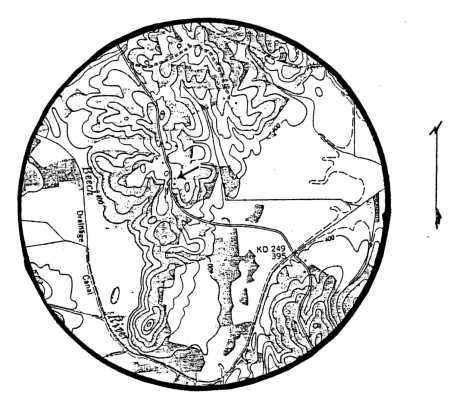
Joseph Reed and his family were the first permanent settlers of Henderson County. A lingering story has it that he and his two sons entered the area in the fall of 1817, travelling down the Tennessee River, then west on or along its tributary, Beech River; and as he decided to bring the rest of his family to make their home in what became Henderson County, he left Jack, aged eleven and William, aged seven, with some Indians in the area, to spend the ensuing winter among these folks, while he returned to North Carolina to bring out the remainder of his family.[1]
The present writer believes this story is essentially apocryphal with elements of fact intermingled with overlapping memories. For certain the Reeds didn't come out from North Carolina as the various censuses reveal that Joseph Reed's children were born in Georgia, including Jack and William. Likely as the case of many others of the time they made the trek from Georgia into Tennessee for settlement purposes, via the southern portion of the Tennessee River. Why a man would leave such young children in a wilderness with Indians, possibly never to see them again, is unclear. Also, the commissioners appointed in 1816 to lay the road that came to be known as the Natchez Trace remarked in their report that there were no inhabitants in this part of the Chickasaw Indian territory. (Indians only hunted in this domain.) So, while many people may believe this old story, others may honestly have their doubts about its veracity. In any event, Reed descendants may take interest that their forebear was Henderson County's first permanent settler (along with his immediate family).
When James Vaulx Drake was visiting in Henderson County in 1878, gathering local history, he quite evidently spoke with John L. Reed, the Jack Reed of the story related above, writing in his notes, in part, "John Reed, now in his 75th [72nd] year, has lived here longer than any other man in the county, having lived here since 1818 [not 1817]". The note in its entirety:[2]
(Page 15)
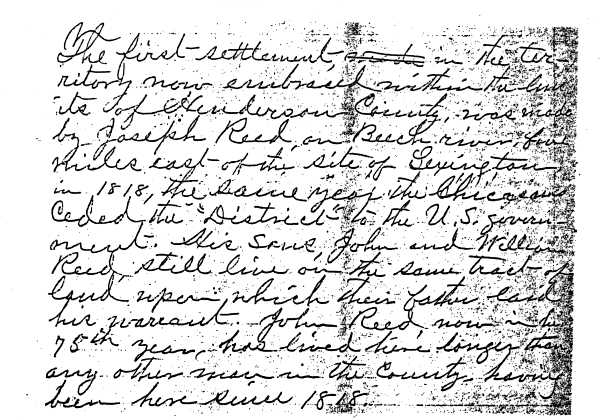
The Chickasaw Indians ceded western Tennessee and southwestern Kentucky to United States commissioners in October 1818; this territory became part of the State of Tennessee known as the Western District; it was mapped and surveyed, laid out in surveyor districts, ranges and sections. It was only in late 1820 that people were allowed to claim and enter land in this vast area, although numerous "squatters" had already entered the territory, staking out their claims for land not already taken by previous speculators years before.
Joseph Reed staked his claim to 160 acres just north of Beech River, off the road that had just been cleared in the wilderness, the Natchez Trace commonly called "the Notchey" by early settlers. Henderson County was not created by the state legislature until November 1821; previous to that time the area that became this county lay largely within the jurisdiction of Perry County, the western boundary of which officially lay along the Tennessee River.
The State of Tennessee granted 160 acres of land to Joseph Reed in Surveyor District 9, Range 6, Section 9, then considered in Perry County, April 16,1822. He had acquired the right to this acreage from Samuel Wilson, the principal surveyor of this district, and entered it (staked his claim officially) October 1,1821; it had been surveyed by date of October 2,1821. The bounds were described, "lying in the ninth district in Perry County, in range six, section nine and bounded as follows, to wit, beginning at a black oak and dogwood ninety six poles east and twenty five poles north of the south west corner of said section, running thence east one hundred and fourteen poles to two beeches, thence north two hundred and twenty six poles to two white oaks, thence west one hundred and fourteen poles to a poplar and dogwood, thence south two hundred and twenty six poles to the beginning."[3]
The original land grant (document) has survived and is presently owned by the family of Mrs. Gladys Jones Snider who lives on the old Reed homeplace. This treasured document, bearing its official seal, is in remarkably sound condition (the copy of it reproduced on the following page was provided the present writer by Linda Ancell Fiedor, a Reed descendant).
(Page 16)
ORIGINAL LAND GRANT DOCUMENT
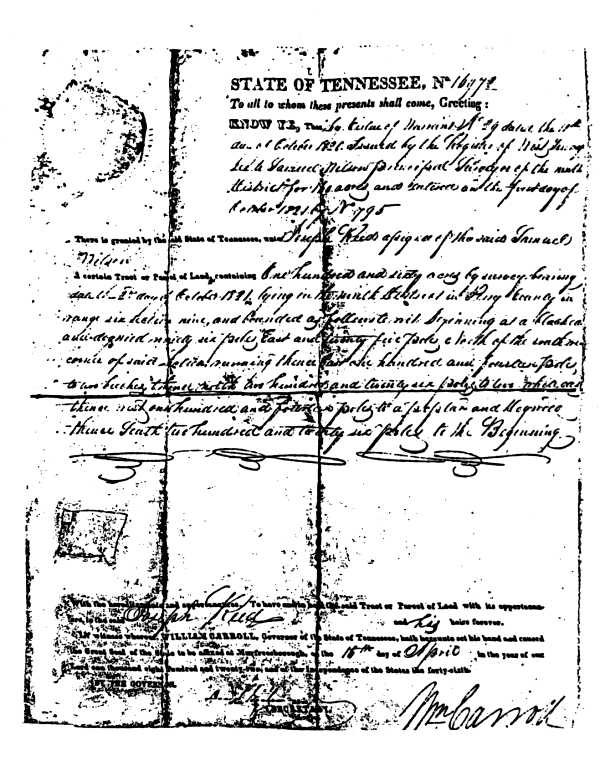
LAND GRANT BOOK COPY OF REED GRANT
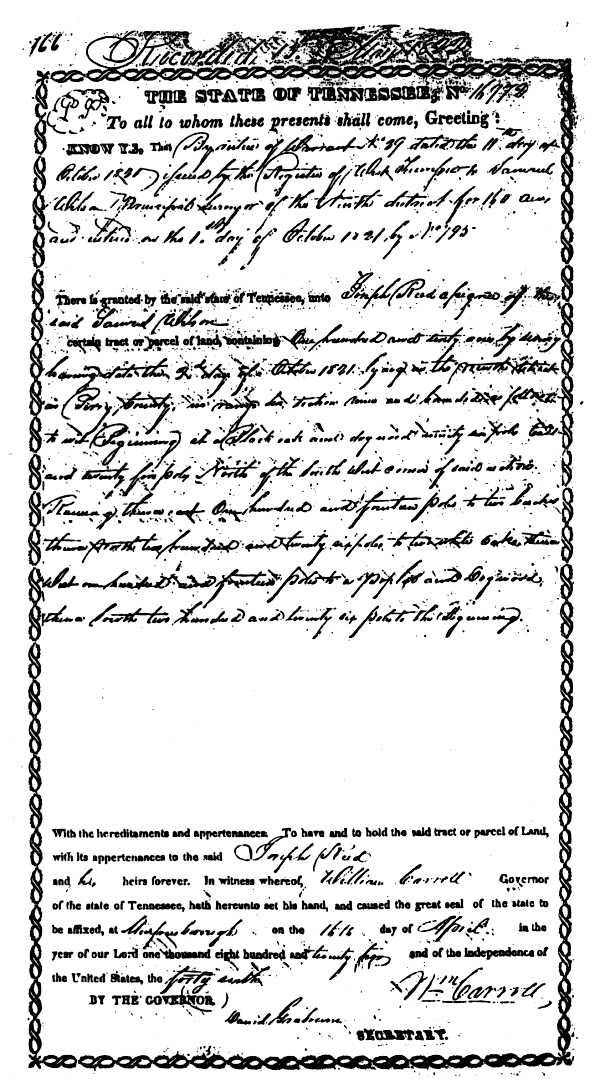
Joseph Reed built a large one-room dwelling out of pine logs from the Pine Knobs, on the ground immediately south of the Notchey. A smaller log room was built adjacent to it, serving as a detached kitchen. Some of the descendants of Joseph Reed, in the William Reed line of descent, occupied this home site. Auburn Powers wrote of this old dwelling at a time when it was occupied by Miss Elvira Reed (1873-1955) and her Snider relatives, noting that the house originally stood a few yards from the present house site. At some point in time, perhaps early in the 1900s,the one room was moved slightly from its first site, becoming converted into what became a livingroom in an enlarged frame house in which Miss Reed's nephew, Goy Snider, his wife and children lived and where his widow, Gladys Jones Snider, still lives. In 1955 the old kitchen was pulled further east to stand in the backyard of this homeplace.
As Powers remarked about Joseph Reed and his sons:[4]
|
The father and boys then went to what is now known as the "Pine Knob" and began to fell trees with which to build their new home. They cut and hewed the logs out of huge pine. The manner in which Mr. Reed hauled them to the place is unknown, but he forded Beech River with them, there being no bridges or ferries at that time. They built the house out of these logs and covered it with boards held in place by poles, for there were no nails to be had; but, all-in-all, it was a good house, the logs still being sound and in use in Miss Elvar Reed's home only a few yards from the ste of the old house. |
(Page 17)
Just below the house site, to the southwest, and on the opposite side of Shady Hill Road was a clear spring from which the family got its water supply for many years. (The springs dried up eventually.[5]) They were just far enough south of the trace to avoid having travellers pollute their springs.
As a very old widower, Joseph Reed's presence was noted in the household of his son, William Reed, by the census-taker in 1860, assigning him the age of 101 years and as a native of Maryland.[6] The previous ten-year censuses would suggest that this date (about 1759) is "about right." In the 1820 census of Perry County he was simply listed by approximate age, indicating that he was over forty-five years old [7]; in 1830, his age category suggested that he had been born in the 1760s.[8] Perhaps after his marriage in Maryland, Joseph Reed moved to Georgia, or he may have married in the latter state, where his children were born. The family name was variously spelled, Read, Reid; finally Reed.
The family record indicates that Joseph Reed and his wife, Mary, had children: Armintee, 1802-1849,wife of William Atkinson; Polly Matilda, 1803-1855; John Leverett, 1806-1879; Joseph,Jr., 1808-1863;William, 1810-1886.[9]
Mary Reed, wife of Joseph Reed, is sometimes given as having been born in 1768 and as having died in 1859. These are suppositions, as no contemporary record of her birth and death (as in a Bible record) is known to be in existence. In the Henderson County Court Minute Book, 1860-1866, page 179, it is recorded under date of January 6, 1862, "This day papers purporting to be the last will and testament and codicils thereto appended of Joseph Read late of Henderson County deceased were produced in open court and offered for probate, the original will being dated the 27th day of April 1852, the first codicil being dated the 17th day of March 1853 and the second codicil being dated the 19th day of January 1855, whereupon R. B. Jones and G. H. Buck subscribing witnesses to said original will were called into court ... do say and testify that they saw ... [Joseph Reed] sign and seal said will." [The witnesses of the codicils also affirmed Reed having declared them his wishes.] [10]
The present writer belives that Joseph Reed, who the record would suggest died in 1861, made one of these codicils after the demise of his wife, which event would have necessitated his making disposition of his property differently than had his wife survived him. In any event, he was a widower living in the household of his son, William Reed and his family in 1860.
THE REED GRAVEYARD
To reach the Reed burial ground drive east from court square in Lexington on U.S. Highway 412 (State 20) to a point at about 3.4 miles to Shady Hill Road; turn right (south) onto this road and drive about 1.8 miles to a point on the east side of this road, the Mrs. Gladys Jones Snider residence, the ancestral Joseph Reed homeplace, behind which about .2 mile to the southeast is the Reed graveyard. The present writer read the tombstone inscriptions there in the fall of 2001.
ELLEN, wife of Willaim Reed
Born Dec. 10,1822
Died Dec. 2, 1902
Beloved
W. M., consort of Ellen Reed
Born Dec. 5, 1810
Died Oct.19, 1886
Aged 75 yrs 10 mos 14 ds
[a broken tombstone]
J.M.FERGUSON
(Masonic emblem)
Born June 16,1834
Died Sept.12,1890
Into thy hands I commend my spirit.
JAMES W., son of C. V. & Mrs. M. E. Reed
Born Nov. 24, 1871
Died Mar. 14, 1872
Sleep on dear child and take thy rest
in Jesus' arms, forever blessed.
(Page 18)
Erected by J. M. Ferguson,
MARY ANN wife of J. M. Ferguson
Born Feb. 23, 1836
Died Jan. 28, 1907
Aged 71 ys 11 mos 3 ds
A previous one from us has gone, A voice we loved is stilled.
A place is vacant in our home which cannot be filled.
God in his wisdom has recalled thee home, his love had given.
Though the body slumbers here the soul is safe in heaven.
[a broken tombstone]
JOHN L. Reed
Born Mar. 9, 1806
Died May 30, 1879
[This tombstone is virtually destroyed by the elements]
Sacred to the memory of
JOHN H.REID
Who departed this life the 21 of January 1849
Aged 2 years
[footstone reads JHRC]
Infant DAUGHTER of C. V. & M. E. Reed
Born Nov. 16, 1882
Died Nov. 18, 1882
Sleep on, sweet babe, and take thy rest.
God called thee home. He thought it best.
Infant SON of C. V. & M. E. Reed
Born Sept. 2, 1870
Died Sept. 2, 1870
Sleep on dear babe and take thy rest.
God called thee home. He thought it best.
FRANCIS E., daughter of C. V. & M. E. Reed
Born July 25, 1880
Died May 14, 1893
Her spirit smiles from that bright shore and softly whispers weep no more.
Tradition has it that Joseph Reed,Sr.(died 1861) and his wife, Mary, are buried in unmarked graves here.
NOTE: There is supposedly a family relationship between Joseph Reed and John H. Reid but if so the nature of that relationship is now unknown. The latter's tombstone inscription has been subject to different interpretations. The tombstone has fallen, is broken in pieces, and the inscription is dimmed from the elements. The present writer renders the inscription as he reports it in the listing above. Some individuals, not accustomed to reading very old inscriptions, have said the death date is 1811 which commonsense (due to time and place) dictates cannot be correct. There is no reason to assume the tombstone was brought here from elsewhere in the distant past. The fact is that old-time stone-cutters often made the triangle in the numeral four lighter (perhaps from fashion) and when this part of the numeral wears away, only the bar is visible except under the closest and impartial scrutiny. It is a matter of no personal consequence to the present writer but he believes accuracy rather than fancy should determine what is revealed on stone or in writing.
On March 23, 1849, shortly after John H. Reid died, the administrator of his estate, J. L. Ross, published through the county court clerk, notice that "all persons having claims against said estate [Reid's] to file them with the clerk of said court duly authenticated on or before the 5th day of November 1850."[11]
John H. Reid's tombstone has a mystery about it. The age given for him is decidedly inscribed "2 years" but this again surely cannot have been the case. It wouldn't be the first instance of a stone-cutter's mistake, accepted by heirs for various reasons including refusal to pay additional fee for major corrections. There is, of course, the possibility that an infant child, a son bearing his name, of John H. Reid who was deceased by May 1849, died at nearly the same time as his father. It has even been suggested that this is the case, obliquely reflected in the footstone inscribed JHRC [C = child?]. Was the grave of the senior Reid never marked or has his tombstone been carried off?
John H. Read is listed in Civil District 13 of Henderson County, owner of 100 acres valued at $1000 (and a slave valued at $1450) in the 1836 tax list of the county. The 1840 census entry for John H. Read suggests that he was then in the 30-40 age category:[12]
(Page 19)

Click here for larger image.
If the tombstone is that of an adult John H. Reid, then his age was more nearly 42.
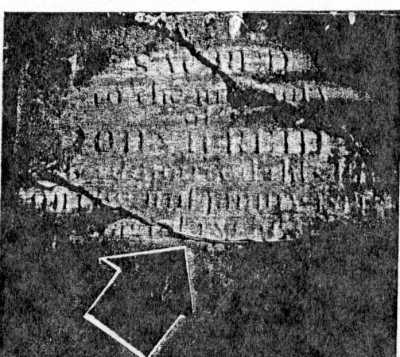
REFERENCES
1. HISTORY OF HENDERSON COUNTY, TENNESSEE, by Auburn Powers,1930, pages 13-14. Hereafter cited as Henderson:Powers.
2. Notes about Henderson County in the miscellaneous manuscripts of the Tennessee State Library and Archives, Nashville. The compilers of Goodspeed's HISTORY OF TENNESSEE (c 1887) drew heavily upon these notes and those regarding other Tennessee counties.
3. Tennessee General Land Grant Book T, page 166. Land Grant #16972 bearing the signature of Governor William Carroll.
4. Henderson:Powers, page 16. Also, interview, Jonathan Smith with Willie Powers Trammell (born 1907), December 20, 2001, in which she recalled the residence of Miss Elvira Reed and the Sniders.
5.Conversation,Jonathan Smith with Gladys Jones Snider (born 191]+),Pecember 622001.
6. U.S., 1860:Henderson County, Tennessee, Civil District 20, page 328.
7. IBID., 1820:Perry County, Tennessee, page 271.
8. IBID., 1830:Henderson County, Tennessee, page 113. The 1840 census (page 356) would place his birth in the 1770s; the census-taker seems to have missed his household in 1850.
9. J0SEPH REED,SR.AND HIS FAMILY THROUGH THE YEARS, by Clefaine Eeed King, 1991, page 7. There were probably other children who didn't live to adulthood.
10. In the WPA transcript (page 126) of this entry the existence of the second codicil was accidentally deleted.
11. THE WEST TENNESSEE WHIG, Jackson, Tenn., May 4, 1849. The notice, costing $8, was published in several issues of this newspaper. Reid's name was spelled READ in these notices.
12.U.S. Census, Henderson Co., Tenn., page 363.
Other works by Jonathan K. T. Smith can be found at the Madison County Records Repository at TNGenWeb.
Return to Table of Contents for A Genealogical Miscellany Henderson County Tennessee
volume I · volume II · volume III · volume IV · volume V · volume VI · volume VII
